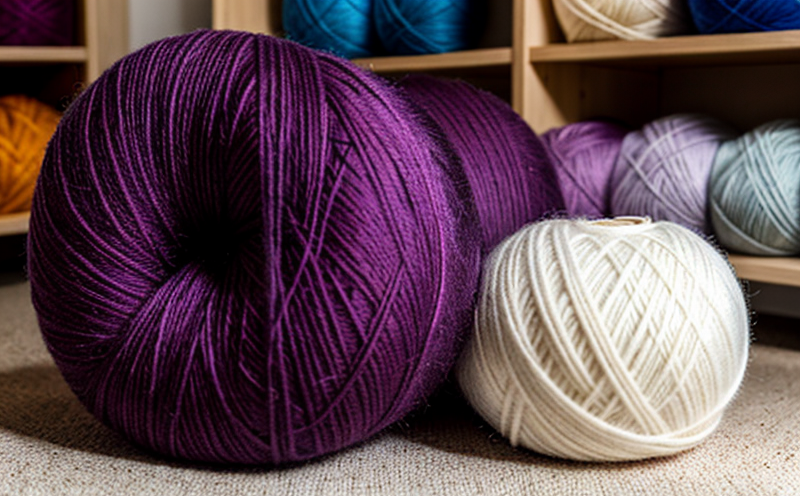BS 2010 Testing Yarn Evenness with Uster Instruments
BS 2010 is a British Standard that specifies requirements and test methods for the evaluation of yarn evenness. This standard plays a crucial role in ensuring consistent quality across various textile products, from fibers to fabrics. Compliance with BS 2010 is particularly important for manufacturers who need to meet stringent quality control standards.
The testing of yarn evenness using Uster instruments is essential because it helps identify variations in the thickness and structure of a yarn during its production process. These variations can significantly impact the performance, durability, and appearance of textiles. By detecting such inconsistencies early on, manufacturers can take corrective actions to maintain high standards.
The Uster Evenness Analyzer (UEA) is commonly used for this purpose. The UEA measures both the percentage deviation from average weight per meter and the coefficient of variation (CV). These metrics provide valuable insights into the consistency of yarn production. A lower CV indicates a more uniform yarn, which contributes to better textile quality.
Understanding the parameters involved in BS 2010 testing is crucial for achieving accurate results. The standard specifies that samples should be cut into lengths ranging from 3 meters to 5 meters, depending on the type of yarn being tested. Preparing these specimens correctly ensures reliable measurements. Specimens must also be free from defects like neps or weak spots.
Once prepared, the specimens are fed into the UEA machine. The instrument scans each specimen multiple times, capturing detailed data points about its evenness. This process involves illuminating the yarn with light and measuring how much of it is illuminated at different points along its length. Variations in this illumination directly translate to differences in yarn thickness.
The results generated by UEA are then analyzed according to BS 2010 criteria. The percentage deviation from average weight per meter quantifies the degree of variation observed, while CV provides a statistical measure reflecting overall uniformity. Both values give operators clear indicators about whether their production processes meet required standards.
Implementing BS 2010 testing with Uster instruments offers numerous benefits beyond mere compliance. It enables companies to enhance product quality consistently by identifying problem areas early in the manufacturing cycle. Additionally, this approach helps reduce waste and improve efficiency within textile operations.
To summarize, adhering to BS 2010 standards through Uster instrument testing ensures consistent yarn evenness across all stages of production. This commitment not only enhances product quality but also strengthens brand reputation among consumers seeking superior textiles.
Applied Standards
| Standard Reference | Description |
|---|---|
| BS 2010: Part 4 | This part of the British Standard outlines specific requirements and test methods for evaluating yarn evenness. |
| ISO 13689-5 | An international standard that complements BS 2010 by providing additional guidance on measuring yarn evenness using advanced techniques. |
Scope and Methodology
| Methodological Aspect | Description |
|---|---|
| Sample Preparation | Samples should be cut into lengths of 3m to 5m, depending on the yarn type. |
| Instrumentation | The Uster Evenness Analyzer (UEA) is used for scanning and measuring yarn evenness accurately. |
| Data Analysis | Results are analyzed based on BS 2010 criteria, focusing on percentage deviation from average weight per meter and CV. |
Use Cases and Application Examples
In the textile industry, ensuring yarn evenness is critical for maintaining consistent quality across various products. Implementing BS 2010 testing with Uster instruments allows manufacturers to pinpoint areas where improvements are needed. For instance, a weaver might notice fluctuations in weave density due to uneven yarns during production.
One practical application involves monitoring raw materials before they enter the manufacturing process. By conducting initial tests on incoming fibers or spun threads, companies can determine if any preprocessing steps are necessary to achieve desired evenness levels. Another scenario could involve quality assurance checks at different stages of processing—such as spinning, warping, and weaving—to ensure that each operation contributes positively towards final product uniformity.
Suppose a company aims to introduce new yarn types or improve existing ones. In such cases, BS 2010 testing can help identify potential issues early in development cycles, allowing for iterative refinements until optimal evenness is achieved. Furthermore, this level of control ensures that any changes made during production do not compromise overall textile quality.
Textile companies operating internationally often face challenges related to meeting diverse market requirements. Adhering to BS 2010 standards provides a standardized approach that aligns with global expectations regarding yarn evenness, thus facilitating smoother operations across borders.
In conclusion, integrating BS 2010 testing into regular quality assurance practices offers significant advantages for textile manufacturers. It enhances product consistency, supports continuous improvement initiatives, and fosters adherence to international standards, ultimately leading to higher customer satisfaction and increased competitiveness in the marketplace.





